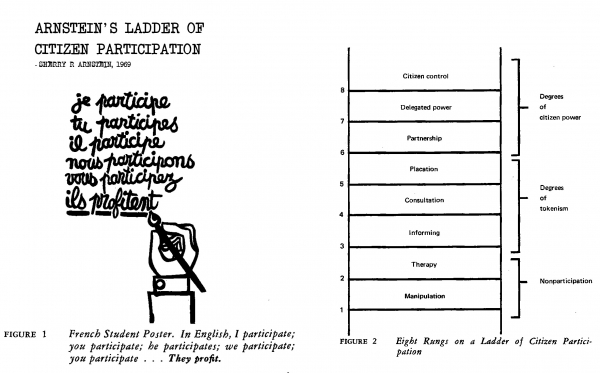
Working Our Way Up The Ladder
"The idea of citizen participation is a little like eating spinach: no one is against it in principle because it is good for you. Participation of the governed in their government is, in theory, the cornerstone of democracy - a revered idea that is vigorously applauded by virtually everyone. The applause is reduced to polite handclaps, however, when this principle is advocated by the have-not blacks, Mexican-Americans, Puerto Ricans, Indians, Eskimos, and whites.
And when the have-nots define participation as redistribution of power, the American consensus on the fundamental principle explodes into many shades of outright racial, ethnic, ideological, and political opposition."
"There is a critical difference between going through the empty ritual of participation and having the real power needed to affect the outcome of the process. This difference is brilliantly capsulized in a poster painted last spring by the French students to explain the student-worker rebellion.* (See Figure 1.) The poster highlights the fundamental point that participation without redistribution of power is an empty and frustrating process for the powerless. It allows the powerholders to claim that all sides were considered, but makes it possible for only some of those sides to benefit.
It maintains the status quo."
"A typology of eight levels of participation may help in analysis of this confused issue. For illustrative purposes the eight types are arranged in a ladder pattern with each rung corresponding to the extent of citizens’ power in determining the end product (See Figure 2.)
The bottom rungs of the ladder are (1 ) MANIPULATION and (2) THERAPY. These two rungs describe levels of “non-participation” that have been contrived by some to substitute for genuine participation. Their real objective is not to enable people to participate in planning or conducting programs, but to enable powerholders to “educate” or “cure” the participants.
Rungs 3 and 4 progress to levels of “tokenism” that allow the have nots to hear and to have a voice: ( 3 ) INFORMING and (4) CONSULTATION. When they are proffered by powerholders as the total extent of participation, citizens may indeed hear and be heard. But under these conditions they lack the power to insure that their views will be heeded by the powerful. When participation is restricted to these levels, there is no follow through, no “muscle,” hence no assurance of changing the status quo.
Rung (5) PLACATION, is simply a higher level tokenism because the groundrules allow have-nots to advise [SEE CURRENT TREND FOR 'ADVISORY GROUPS' OR SUB COMMITTEES OF ONE KIND OR ANOTHER], but retain for the powerholders the continued right to decide.
Further up the ladder are levels of citizen power with increasing degrees of decision-making clout.
Citizens can enter into a (6) PARTNERSHIP that enables them to negotiate and engage in trade-offs with traditional powerholders.
At the topmost rungs, (7) DELEGATED POWER and ( 8 ) CITIZEN CONTROL, have-not citizens obtain the majority of decision-making seats, or full managerial power.
Obviously, the eight-rung ladder is a simplification, but it helps to illustrate the point that so many have missed - that there are SIGNIFICANT GRADATIONS OF CITIZEN PARTICIPATION. Knowing these gradations makes it possible to cut through the hyperbole to understand the increasingly strident demands for participation from the have-nots as well as the gamut of confusing responses from the powerholders."
Taken from Sherry R Arnstein's 'Ladder of Citizen Participation', published in 1969.
It came out two years before the forming of the North Kensington Amenity Trust in 1971, which sits somewhere between Rungs 1 and 5, under the guise of Rung 6.
[NOTE - The need to ensure that the current Review into Institutional Racism at the Westway Trust is not allowed under any circumstances to be reduced to a simple exercise in Rung 2 - THERAPY, where we restless natives can be educated out of our "perceptions". Or Rung 5 - PLACATION - where we get one more version of an advisory group with no decision-making power]

